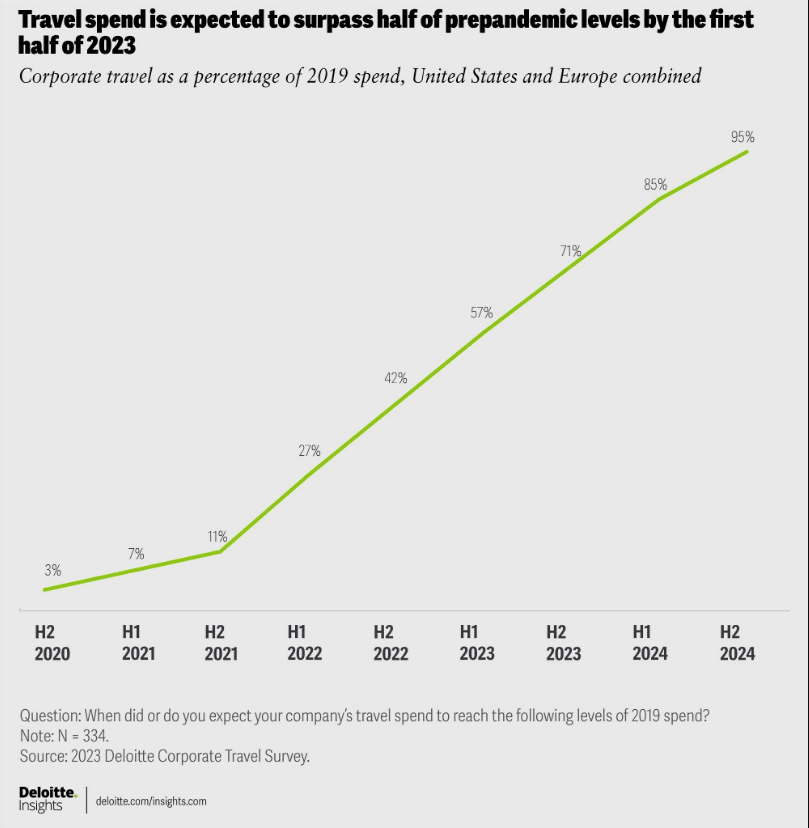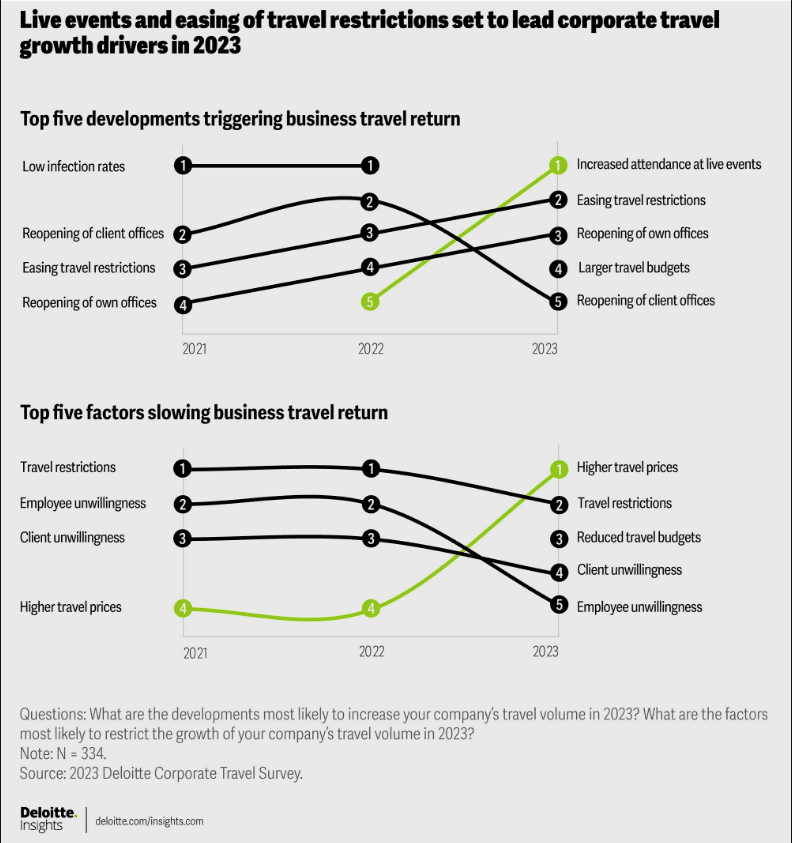Even though leisure travel appears to have largely recovered from the pandemic’s damage, corporate travel has been slower to return—and now that businesses have figured out alternatives, will it ever fully recover? Is there still a need?
New Deloitte research points to a variety of factors that are contributing to that decline, including heightened employee safety concerns, a declining client interest in meeting in-person, the re-assessed value of attending a conference, the sufficiency of virtual conferencing platforms, and increased concerns about sustainability.
Although pandemic concerns and testing regulations generally waned in the second half of 2022, financial concerns are now a bigger uncertainty for the sector. The third edition of Deloitte’s corporate travel study, Navigating Toward a New Normal, examines why and when employees are expected to travel for business, as well as the dynamics creating headwinds—and opportunity—for the sector.
International travel and events account for much of expected growth in 2023
While full recovery to 2019 levels may be possible by late 2024 or early 2025, accounting for inflation and lost gains would potentially leave the corporate travel market between 10-20 percent smaller than it was prior to the pandemic. Amid higher airfares and room rates, the number of trips is likely to lag even further behind. However, international trips and live events are set to account for much of expected growth in 2023.
- Corporate travel spend across the U.S. and Europe is expected to rise to more than half (57 percent) of pre-pandemic levels in the first half of 2023 and surge to 71 percent by the end of the year.
- Most companies surveyed (71 percent of U.S. companies and 68 percent of those in Europe) expect a full recovery in travel spend by the end of 2024.
- U.S. respondents expect international trips to account for 33 percent of 2023 spend, up from 21 percent in 2022 and similar to 2019 levels.
- The top reason reported for international trips involves connecting with clients and prospects: in the U.S., the main drivers are to connect with global industry colleagues at conferences and to build client relationships; in Europe, client project work, followed by sales meetings are the biggest reasons for trips beyond the continent.
- While higher travel prices are the most significant factor deterring companies from travel, live events are poised to be the major driver of business travel demand, leapfrogging to the top reason for international travel from the U.S. in 2023, up from fifth in 2022.
- With events top of mind, companies are adjusting their internal plans: Half report splitting larger gatherings into smaller, regional, virtually connected events, and 44 percent have adopted a hybrid approach. Further, 42 percent of those surveyed in the U.S. and 54 percent in Europe plan to integrate more clients into internal events.
- A majority of companies surveyed (70 percent) strategically evaluate and weigh potential outcomes of business travel, such as revenue generation, alongside the side effects of cost, health risks and emissions.
Workplace flexibility and technology continue to shift the course of business travel
Although pandemic concerns about travel generally declined among those surveyed, the ability to leverage technology in lieu of trips—which ultimately reduces costs—continues to impact business travel’s growth trajectory. According to the survey, technology can support nearly every business need travel serves—to some degree. In addition, the future work-from-home rate is expected to be 3.2 times higher than before the pandemic. Together these factors will continue to impact how and when employees travel for work.
- Business leaders are weighing the benefit of in-person interactions, as internal trainings and team meetings (44 percent) are rated the most replaceable by technology, compared to client rapport building (11 percent) and client acquisition (7 percent).
- Two-thirds (67 percent) of respondents say their employees are traveling more to cities within driving distance of their location.
- Trips to company headquarters by relocated employees are also on the rise, most of which (70 percent) are either completely or partially paid for by the company.
- U.S. companies are increasingly incorporating non-hotel lodging, including private rentals, into their corporate travel policies. Nearly half (45 percent) of those surveyed have non-hotel lodging in their corporate booking tools, up from 9 percent last year, and 57 percent have agreements with specific branded apartment or home rental providers, up from 23 percent in 2022. Only 10 percent of U.S. companies surveyed do not reimburse for non-hotel accommodations, down from half (49 percent) in 2022.
“As business travel continues its climb, higher airfare and hotel costs are likely slowing the increase in trips taken,” said Eileen Crowley, vice chair, Deloitte & Touche LLP and U.S. transportation, hospitality and services attest leader, in a news release. “As business leaders take a strategic view of their travel plans and the industry adapts to a new normal, live conferences and events in particular are proving they can offer effective opportunities to connect in person, especially as remote and hybrid work remain fixtures of the corporate world.”
Contract negotiations aim to right-size travel costs
Companies likely garnered significant cost savings from not traveling during the pandemic. Now, after three years of reduced travel, higher airfare and room rates driven by inflation have many companies working to accommodate shifting expectations from their employees.
- About half of respondents (51 percent) report employees’ expectations of luxury services such as first or business class airfares and upscale hotels, as well as the need for last-minute (45 percent) or flexible bookings (52 percent), are pushing costs higher.
- When negotiating contracts with suppliers, about 1 in 5 (19 percent) companies say hotels are less accommodating on rates because they expect lower volume, and 11 percent report the same for airlines.
- Regionally, 63 percent of U.S. travel buyers surveyed report favorable airline pricing on positive volume expectations, compared to 54 percent of those in Europe.
- Higher rates are having less of an impact on the number of trips taken: 45 percent of companies say they limit frequency to control costs, down from 72 percent in 2022. Instead, they focus on mitigating the cost per trip with cheaper lodging (59 percent) and lower-cost flights (56 percent).
Sustainability drives some travel decisions
Travel, in general, attracts attention as a significant contributor to carbon emissions. However, 49 percent of companies noted that choosing sustainable providers drives costs up. As a result, business leaders are forced to weigh the expense and environmental impact of trips.
- One-third (33 percent) of U.S. companies and 40 percent of European companies surveyed say they need to reduce travel per employee by more than 20 percent by 2030 to meet sustainability targets.
- To meet sustainability goals, 42 percent of those in the U.S. and 45 percent in Europe say they are in the process of implementing a structure to assign carbon-emission budgets to teams alongside financial budgets.
- Travel suppliers’ sustainability efforts lead to engagement with travel buyers to varying degrees. Mandated use by survey respondents is low, however, about one-third consider factors like a hotel’s sustainability certifications and ratings (32 percent), an airline’s use of sustainable fuel (31 percent), or a car rental fleet’s availability of electric vehicles (27 percent) to calculate a trip’s carbon footprint.
“The return of corporate travel continues to take a winding road as both business leaders and travel suppliers consider not just rising costs, but the necessity of certain in-person meetings amid the increasing use of technology to offset financial and environmental goals,” said Mike Daher, vice chair, Deloitte LLP and U.S. transportation, hospitality and services non-attest leader, in the release. “Suppliers who take a long-term view of their relationships with travel buyers and communicate with them about their sustainability progress should be better poised to navigate ongoing shifts in travel priorities.”
The study is based on a survey of 334 U.S.-based and European executives with travel budget oversight, fielded between Feb. 7 and Feb. 23, 2023.





